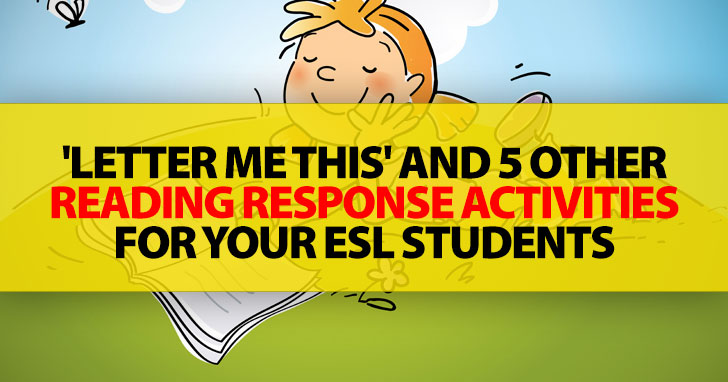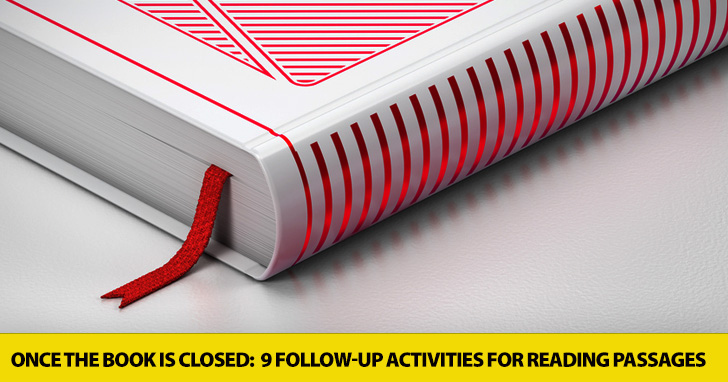'Letter Me This' And 5 Other Reading Response Activities For Your ESL Students


If we don’t prepare them for what they will find between the pages, their comprehension will decrease and their stress will increase. But as important as it is to do activities before reading, it is also important to do follow-up activities with your ESL students. Follow-up activities give you a chance to check comprehension, review important information, and extend your reading activities. Here are some ideas of activities you can do with your students once they are finished with their reading assignment.

A simple follow-up activity for any reading passage is having your students retell the story. You can put as much preparation into the activity as you like, either leaving students to their own creative devices or providing props for them to use in the retelling. If you like, have students retell the story or sections of it in skit form. You will know if they have absorbed all the important points in the story if they include them in the retelling.
Choose or highlight specific words in text. Have your students find the definitions of those items in the text. You can also have them write a definition in their own words based on the context of the items in the reading passage.
Creating story boards is also a good way to follow up reading activities with your students. If you have read a picture book, make a copy of every page in the book for the activity. If you have read something with few or no pictures, use smaller pictures that represent the different events in the story. Separate and shuffle the pictures, and then have your students put the events from the story in the correct order.
Writing summaries is always a good follow-up activity, and it doesn’t require any prep work for you. Ask your students to write a one page summary of a longer passage they have read. To make it even more challenging for them, have them take their one page summary and pare it down to just one paragraph. Follow that by having them condense their paragraph long summary into just one sentence.
Another great follow-up activity is to have your students write comprehension questions for their classmates. This activity does double duty. First, students have to understand what they read and what was most important in the text in order to write the questions in the first place. They have be able to pick out the key points in what they have read. Then, once students exchange their questions with each other, they will have to answer the question their classmates have written. This ensures that they have also understood what their classmates thought was most important in the text.
If you have your students read essays or short stories in class, you might want to see if they can write in the same structure or style as what they read. In which case, the reading passage they have completed can serve as a model for what they themselves will write. If your students have read a short story, have them break down the major plot points and make notes on why each piece is important in the story. If they have read an essay, have them look at the function and purpose of each paragraph. Then have them follow the same pattern when they write their own story or essay.
If your students have read an opinion piece, such as an editorial or personal opinion essay, you can use what they have read as a starting point for sharing their own opinions. Break your class into groups of three or four, and have them discuss the points or arguments the writer presented in his written piece. Then have your students discuss whether or not they agree with what they writer said. Follow up by having each person write their own editorial, letter to the editor, or letter of response to the author. If any of your students does a particularly effective job on their letter to the editor, have them send it in to the paper and see if it gets printed.
How many critics do you have in your ESL class? They may not act that way all the time, but everyone is a critic at some point or another. If your students have read a book, either in its complete form or an abridged version, have them write a book review as a follow-up activity. Have them model it after a movie review they see online or in a newspaper. Then post your students’ book reviews on a bulletin board in class. If everyone has read a different book, have your class vote on whether they would read each book based on the review their classmate has written.
Once your students have finished reading a story or fictional composition, you can follow-up your reading with an opportunity to share something personal. Rather than having your students illustrate someone or something from the story, have them think about what the story means to them. It might bring back a memory or touch on one of their personal values. Have each person in your class draw a picture that represents what the story means to them. Then give your students a chance to share with each other what they drew and what it means.
As your students respond, they internalize information and make personal connection to the words on the page. These are just a few ways to respond to a reading assignment. Which are your favorite activities for responding to a reading passage? Please share it with us in the comments section below.